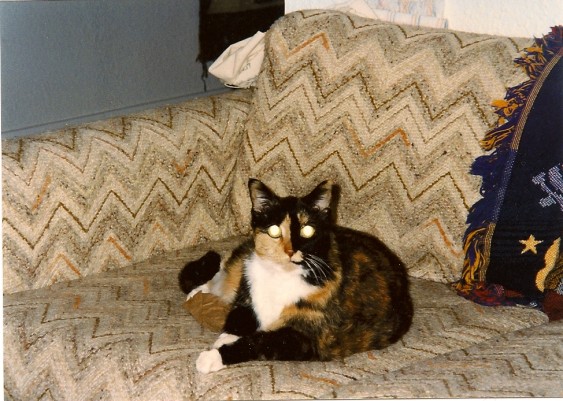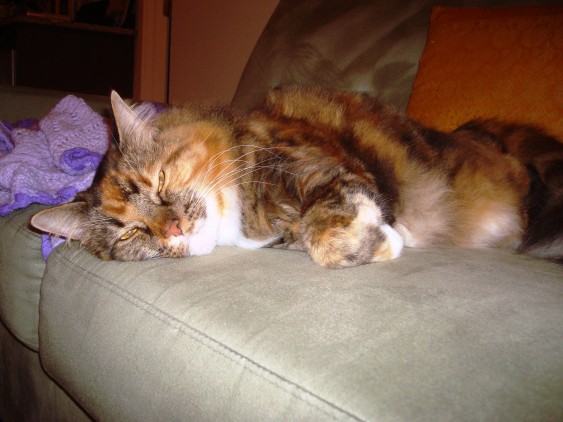Readers have been answering my call to send in photos of the creatures most exposed to toxic flame retardants in couches. These chemicals lace our furniture, because of an obscure and counterproductive California regulation called the “12-second rule.” Today, in a shameless attempt to tug on your internet weakness for pet photos, I offer you nine puppies and kittens who have lived their lives on and around these upholstered menaces. I also list nine reasons to repeal the 12-second rule.
1. Repeal the 12-second rule for Bacon . . . and because it causes foam makers to blend a range of toxic compounds into furniture foam. These substances crumble out of furniture and contaminate house dust. Adults, children, and especially pets ingest them. US cats, which regularly lick the dust off their coats, carry flame retardants at 20 to 100 times the concentrations of adult American humans. The chemicals have insinuated themselves into food webs worldwide.
2. Repeal the 12-second rule for Lulu . . . and because the California flammability standard involves exposing furniture foam to a flame like a cigarette lighter. If it doesn’t ignite in 12 seconds, it passes. In 1975, when California adopted the rule, cigarette smoking was a gigantic in-home fire risk, but nowadays, far fewer people smoke, and cigarettes are all “fire-safe.” They burn out quickly if left untended.
3. Repeal California’s 12-second rule for Arlo . . . and because it has already stocked most homes in North America with several pounds of toxics apiece. It’s time to stop! California is the biggest US market, so manufacturers tend to treat the 12-second rule as a North American law. If you check under your couch cushions, you’re likely to find a tag saying that your sofa satisfies the California flammability standard. The United States and Canada should each have true national standards, and the US Consumer Product Safety Commission has already drafted one: a superior fire-safety rule for furniture, based on all the most-recent research. It does not rely on a test that favors the use of toxic chemicals, as does the 12-second rule. Repealing the California rule would encourage Washington, DC, to finally adopt its draft furniture flammability rule. (And whatever Sacramento does, Washington should issue its own rule pronto anyway.)

4. Repeal the 12-second rule for Raven . . . and because the flame retardants that are the most affordable way to satisfy the 12-second rule are toxic. To varying degrees, they can make you, your pets, and other living things infertile, impotent, stunted, fat, diabetic, stupid, malformed, sickly, mutated, cancerous, or dead.

5. Repeal the 12-second rule for Lucy . . . and because it is perfectly useless. We might forgive flame retardants their toxic sins if they kept us from perishing in house fires. But they do not. All the fire-safety studies conducted since its adoption in 1975 show that the 12-second rule fails as a predictor of actual, real-world fire safety. It is scientifically discredited. If fire-safe furniture is what we want, the 12-second rule is irrelevant.

6. Repeal the 12-second rule for Tyler . . . and because the 12-second rule is worse than irrelevant. Real-world tests of fire safety suggest that upholstering our living spaces with flame retardants does nothing to slow fires but does make fires more lethal to us. It makes a fire’s smoke (the main killer in residential blazes) more poisonous. It also endangers firefighters.

7. Repeal the 12-second rule for Rose Tyler . . . and because it doesn’t just put poison in our couches. It affects all upholstered furniture and foam-padded child-rearing equipment such as nursing pillows, baby carriers, and strollers. In fact, because of the 12-second rule, flame retardant chemicals banned for more than three decades in children’s pajamas now make up as much as 5 percent by weight of crib mattresses.

8. Repeal the 12-second rule for Flora . . . and because the only reason it persists, despite its proven irrelevance to actual fire safety, is the aggressive self-interest of four chemical companies. Together, Albemarle, Israel Chemicals, Chemtura, and Tosoh are making many millions of dollars a year from selling toxic flame retardants. They defend the 12-second rule with giant political war chests whenever reform begins to seem likely.

9. Repeal the 12-second rule for Gypsy . . . and because it is time. In 2010 and 2011, an impressive coalition of fire fighters, nurses, public health officials, environmentalists, and toxicologists made the case to a legislative committee in Sacramento for an end to the 12-second rule. Outflanked and outspent by chemical manufacturers (see #8) this year, the coalition is ramping up to fight again in 2012. Make no mistake: the 12-second rule only survives because of its obscurity. Even millions of dollars of lobbying money will prove useless if enough citizens learn that a scientifically discredited and outdated state law in California is poisoning their bodies, their children, and their pets, along with much of the planet’s natural heritage—and doing so without any fire safety benefit whatsoever.
Read more about toxic couches:
- Pt. 1: An Obscure California Regulation Fills Homes with Toxics
- Pt. 2: Puppies, Kittens, and Toxic Couches
- Pt. 3: Putting the Chemical Witness on the Hot Seat
- Pt. 4: Toxic Money
- Pt. 5: Have Toxic Couches Finally Met Their Match?
- Pt. 6: Toxic Couches: the Infographic
Learn more about repealing of the 12-second rule from the Green Science Policy Institute. Sightline is also tracking this issue. You can help right away by sharing your pets-on-the-couch photo! Or kids-on-the-couch photo! Please email to editor (at) sightline (dot) org. We’ll post photos in batches, to illustrate the stakes.
Thanks to Sightline readers who submitted photos for this post: Michelle DePass, Liz Dunn, Migee Han, Callie Jordan, Kirsten Muskat, Joelle Nole, Stacey Panek, and Emma Sinai-Yunker!






Comments are closed.